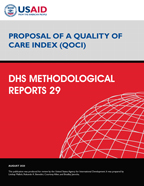There is no printed copy available to order.
Abstract:
As the use of health facilities along the continuum of care for women and children increases, focus must turn toward the provision of effective, high-quality care across services to end preventable maternal and child death. While health management information systems continue to develop, periodic health facility surveys like the Service Provision Assessment (SPA) provide information to monitor progress and target interventions. However, these surveys are complex, and consensus around key indicators or summary measures is lacking. The authors of this report have identified a short list of indicators that measure readiness for and provision of highly effective interventions and propose a quality of care index (QOCI) that spans reproductive, maternal, newborn, and child health and nutrition (RMNCHN) as well as water, sanitation, and hygiene (WASH).
To select the indicators, we conducted a preliminary literature review; an initial set of indicators was then refined following feedback from a group of subject-matter experts associated with the United States Agency for International Development. The agreed-upon indicators reflected international guidelines, had demonstrated relationships with relevant health outcomes, were measurable with current SPA data, and informed readiness to provide services (e.g., availability of medications) as well as observed delivery of services (e.g., providing counseling or appropriately assessing conditions). The QOCI was composed of 17 indicators across six health areas: family planning, antenatal care, delivery care, immunization, child curative care, and WASH. We used a weighted average approach to calculate the index.
Quality could not be directly compared across countries given the differences in indicators and timing of surveys; thus, the findings are reported separately for each country. Within many countries, the QOCI showed geographic differences in total scores. Where comparable items were available across countries, we found that nutritional status was rarely assessed during child curative care visits. Conversely, availability of oral rehydration salts or zinc for diarrhea, WASH resources, immunizations, and blood pressure measurements during antenatal care were common.
This analysis revealed several limitations, both within the index and within the SPA questionnaires. These limitations are discussed in detail in this report, alongside actionable recommendations. In summary, the proposed indicators should undergo additional scrutiny to ensure that they hold the highest construct validity, and the SPA questionnaires should be revised accordingly. The SPA instruments should also align with other tools to more widely monitor progress toward global goals for universal coverage of high-quality health care.
 Proposal of a Quality of Care Index (QOCI) (PDF, 3281K)
Proposal of a Quality of Care Index (QOCI) (PDF, 3281K)
 Proposal of a Quality of Care Index (MR29) Analysis Brief
Proposal of a Quality of Care Index (MR29) Analysis Brief
